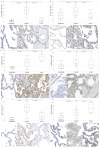COVID-19 and Pulmonary Angiogenesis: The Possible Role of Hypoxia and Hyperinflammation in the Overexpression of Proteins Involved in Alveolar Vascular Dysfunction
- PMID: 36992415
- PMCID: PMC10057465
- DOI: 10.3390/v15030706
COVID-19 and Pulmonary Angiogenesis: The Possible Role of Hypoxia and Hyperinflammation in the Overexpression of Proteins Involved in Alveolar Vascular Dysfunction
Abstract
COVID-19 has been considered a vascular disease, and inflammation, intravascular coagulation, and consequent thrombosis may be associated with endothelial dysfunction. These changes, in addition to hypoxia, may be responsible for pathological angiogenesis. This research investigated the impact of COVID-19 on vascular function by analyzing post-mortem lung samples from 24 COVID-19 patients, 10 H1N1pdm09 patients, and 11 controls. We evaluated, through the immunohistochemistry technique, the tissue immunoexpressions of biomarkers involved in endothelial dysfunction, microthrombosis, and angiogenesis (ICAM-1, ANGPT-2, and IL-6, IL-1β, vWF, PAI-1, CTNNB-1, GJA-1, VEGF, VEGFR-1, NF-kB, TNF-α and HIF-1α), along with the histopathological presence of microthrombosis, endothelial activation, and vascular layer hypertrophy. Clinical data from patients were also observed. The results showed that COVID-19 was associated with increased immunoexpression of biomarkers involved in endothelial dysfunction, microthrombosis, and angiogenesis compared to the H1N1 and CONTROL groups. Microthrombosis and vascular layer hypertrophy were found to be more prevalent in COVID-19 patients. This study concluded that immunothrombosis and angiogenesis might play a key role in COVID-19 progression and outcome, particularly in patients who die from the disease.
Keywords: SARS-CoV-2; angiogenesis; endothelial dysfunction; immunohistochemistry; microthrombi.
Conflict of interest statement
The authors declare that they have no conflict of interest.
Figures



Similar articles
-
Endothelial cell dysfunction, coagulation, and angiogenesis in coronavirus disease 2019 (COVID-19).Microvasc Res. 2021 Sep;137:104188. doi: 10.1016/j.mvr.2021.104188. Epub 2021 May 20. Microvasc Res. 2021. PMID: 34022205 Free PMC article. Review.
-
Endothelial Dysfunction and Thrombosis in Patients With COVID-19-Brief Report.Arterioscler Thromb Vasc Biol. 2020 Oct;40(10):2404-2407. doi: 10.1161/ATVBAHA.120.314860. Epub 2020 Aug 7. Arterioscler Thromb Vasc Biol. 2020. PMID: 32762443 Free PMC article.
-
IL-33 Initiates Vascular Remodelling in Hypoxic Pulmonary Hypertension by up-Regulating HIF-1α and VEGF Expression in Vascular Endothelial Cells.EBioMedicine. 2018 Jul;33:196-210. doi: 10.1016/j.ebiom.2018.06.003. Epub 2018 Jun 18. EBioMedicine. 2018. PMID: 29921553 Free PMC article.
-
Anatomical and Pathological Observation and Analysis of SARS and COVID-19: Microthrombosis Is the Main Cause of Death.Biol Proced Online. 2021 Jan 20;23(1):4. doi: 10.1186/s12575-021-00142-y. Biol Proced Online. 2021. PMID: 33472576 Free PMC article. Review.
-
Endothelial dysfunction contributes to COVID-19-associated vascular inflammation and coagulopathy.Rev Cardiovasc Med. 2020 Sep 30;21(3):315-319. doi: 10.31083/j.rcm.2020.03.126. Rev Cardiovasc Med. 2020. PMID: 33070537 Review.
Cited by
-
COVID-19 Complications: Oxidative Stress, Inflammation, and Mitochondrial and Endothelial Dysfunction.Int J Mol Sci. 2023 Oct 4;24(19):14876. doi: 10.3390/ijms241914876. Int J Mol Sci. 2023. PMID: 37834324 Free PMC article. Review.
-
GWAS-significant loci and severe COVID-19: analysis of associations, link with thromboinflammation syndrome, gene-gene, and gene-environmental interactions.Front Genet. 2024 Aug 8;15:1434681. doi: 10.3389/fgene.2024.1434681. eCollection 2024. Front Genet. 2024. PMID: 39175753 Free PMC article.
-
Matrix metalloproteinase/Fas ligand (MMP/FasL) interaction dynamics in COVID-19: An in silico study and neuroimmune perspective.Heliyon. 2024 May 15;10(10):e30898. doi: 10.1016/j.heliyon.2024.e30898. eCollection 2024 May 30. Heliyon. 2024. PMID: 38803919 Free PMC article.
-
Mechanisms of Pulmonary Vasculopathy in Acute and Long-Term COVID-19: A Review.Int J Mol Sci. 2024 Apr 30;25(9):4941. doi: 10.3390/ijms25094941. Int J Mol Sci. 2024. PMID: 38732160 Free PMC article. Review.
-
Pathogenesis and virulence of coronavirus disease: Comparative pathology of animal models for COVID-19.Virulence. 2024 Dec;15(1):2316438. doi: 10.1080/21505594.2024.2316438. Epub 2024 Feb 16. Virulence. 2024. PMID: 38362881 Free PMC article. Review.
References
-
- Bonaventura A., Vecchié A., Dagna L., Martinod K., Dixon D.L., Van Tassell B.W., Dentali F., Montecucco F., Massberg S., Levi M., et al. Endothelial dysfunction and immunothrombosis as key pathogenic mechanisms in COVID-19. Nat. Rev. Immunol. 2021;21:319–329. doi: 10.1038/s41577-021-00536-9. - DOI - PMC - PubMed
-
- Nagashima S., Mendes M.C., Camargo Martins A.P., Borges N.H., Godoy T.M., Dos Santos Miggiolaro A.F.R., Dos Santos Dezidério F., Machado-Souza C., De Noronha L. Endothelial Dysfunction and Thrombosis in Patients With COVID-19—Brief Report. Arterioscler. Thromb. Vasc. Biol. 2020;40:2404–2407. doi: 10.1161/ATVBAHA.120.314860. - DOI - PMC - PubMed
Publication types
MeSH terms
Grants and funding
LinkOut - more resources
Full Text Sources
Medical
Miscellaneous

